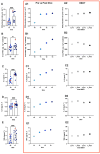Decompression Illness After Technical Diving Session in Mediterranean Sea: Oxidative Stress, Inflammation, and HBO Therapy
- PMID: 39518919
- PMCID: PMC11546868
- DOI: 10.3390/ijms252111367
Decompression Illness After Technical Diving Session in Mediterranean Sea: Oxidative Stress, Inflammation, and HBO Therapy
Abstract
SCUBA diving poses risks due to pressure changes during descent (compression) and ascent (decompression). Decompression sickness (DCS) occurs due to gas bubble formation as the pressure decreases, causing joint pain, numbness, dizziness, or even paralysis and death. Immediate treatment involves 100% oxygen to help eliminate inert gases and hyperbaric oxygen therapy (HBOT), which is essential to reduce gas emboli formation and inflammation, thus improving symptoms. We evaluated oxy-inflammation biomarkers in the saliva and urine of nine subjects pre- and post-technical dive on the Haven wreck (GE, Italy). A case of DCS occurred during the dive. The injured diver was treated immediately with O2 and transported to the hyperbaric center of "ASST Ospedale Ca Granda" in Milan. He was treated following the U.S. Navy Treatment Table 5 at 2.8 ATA and the day after with Table 15 at 2.4 ATA. Venous blood and urine samples were collected before and after each HBO treatment. Our study shows that dive increased oxy-inflammation biomarkers (ROS +126%; lipid peroxidation +23%; interleukins-6 +81%, -1β +19%, and TNFα +84%) and nitric oxide metabolites levels (+36%). HBOT after a DCS episode reduced oxidative stress, lowering the very high marker of lipid peroxidation (8-iso-PGF2α), and inhibited inflammatory interleukins. Overall, HBOT improved physiological responses in the diver affected by DCS.
Keywords: HBO therapy; SCUBA diving; arterial gas embolism; decompression sickness; inflammation; nitric oxide; oxidative stress.
Conflict of interest statement
The authors declare no conflicts of interest.
Figures





References
-
- Van Liew H.D., Flynn E.T. Direct ascent from air and N2-O2 saturation dives in humans: DCS risk and evidence of a threshold. Undersea Hyperb. Med. 2005;32:409–419. - PubMed
-
- Hyldegaard O., Moller M., Madsen J. Effect of He-O2, O2, and N2O-O2 breathing on injected bubbles in spinal white matter. Undersea Hyperb. Med. 1991;18:361–371. - PubMed
MeSH terms
Substances
LinkOut - more resources
Full Text Sources
Research Materials

